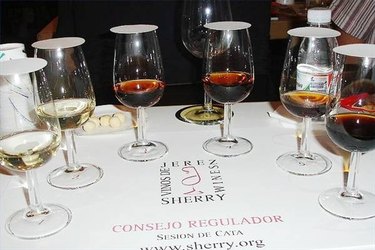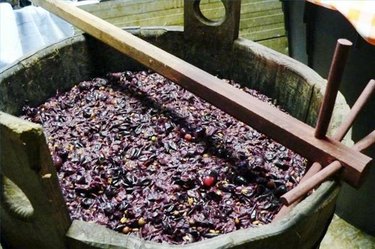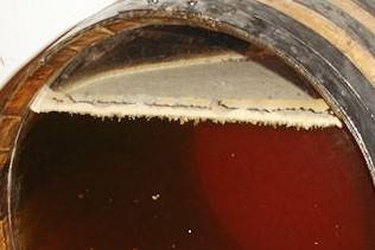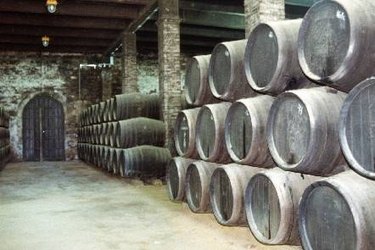Things You'll Need
4 or 5 bushels Palomino, Pedro Ximenez or Moscatel grapes (to make about 10 gallons of must)
Brandy
Large pressing basin and stirring paddle
Stainless-steel fermentation vats
Wooden paddles and dippers
Oak barrels
Glass bottles and corks
pH meter
For home-brewed wine:
1.3 gallons of white-grape concentrate and 5 gallons warm water
10 pounds sugar
5-gram package commercial flor yeast
Fermentation and aging vessels and bottling supplies
Optional ingredients for either process (amounts will vary with type of grapes and chemistry used):
Sodium or potassium metabisulfite crystals or tablets
Acid blend for wine (2-ounce package or more)

Sherry is produced near the southern Spanish town of Jerez, founded nearly 3,000 years ago and named Sherish by the Moors. Cool winters, hot and dry summers, chalky soil and more than 300 days of sunshine per year produce the grapes that make sherry. Although you could make sherry in glass jugs using sugars and sulfites, true sherry-making is an art, producing a range of wines from the dry, clear Fino de Jerez to the amber-colored Amontillado and the sweet, thick, mahogany-hued Oloroso.
Step 1

Use Palomino, Pedro Ximenez or Moscatel grapes, harvested just as they ripen. Press grapes (like Palomino) that will make dry or light sherry immediately but dry grapes that will make sweet or darker wine in the sun to allow the fructose to fully develop before pressing. Crush grapes to form a mash and drain the must, the clear to amber-colored liquid that contains the sugars and proteins from the underside of the skins. Traditionally, only the first pressing of grapes ("mosto de yema") is used to make sherry. Use subsequent pressings in sherry vinegars or cooking or table wines. Home winemakers produce must by adding sugar and yeast to grape juice.
Video of the Day
Step 2
Put the must in a covered stainless-steel vat and allow the grapes to ferment for about two months. Test for alcohol content beginning at about 45 days until the batch reaches an alcohol content of 11 to 12.5 percent. Add premixed sherry flor yeast to jump-start fermentation and add sugar if fermentation begins to slow too early.
Step 3
"Fortify" the wine by adding brandy to "shock" it, stopping the fermentation process. Add enough alcohol to light, dry wines to raise the alcohol content to 15 percent and fortify darker, sweeter wines to 17 percent. Check the wine's pH with a pH meter; it should be between 3.0 and 3.5. Use winemaker's acid (a blend of citric, malic and tartaric acids) to adjust the pH. Add a quarter-teaspoon at a time, stir and then test before adding more.
Step 4

Transfer light or dry wines to oak barrels (botas) for aging. Fill botas to within "two fists" of the top of the cask--about five-sixths of the way--before sealing. A layer of yeast ("flor") will grow on the surface, keeping the air away from the wine. The flor also imparts tastes and aromas that distinguish Fino and Manzanilla sherries. Age these sherries in this manner for two to three years. Wine can be allowed to continue to age in botas or separated from the flor and transferred to "solera" casks. Bottling the wine will not stop the aging process, but it will halt the development of taste and aroma created by the wood barrels. Home winemakers can achieve the flor stage by sealing jugs with stoppers lined with cotton-wool to allow just enough air in the bottle.
Step 5

Age heavier sherries that cannot produce flor due to their higher alcohol content using a rotation called a "solera" system. A cask of aged sherry is half-emptied to make way for a new batch. As batches are made, halves of wine casks are moved along to the next barrel, making the last barrel a blend of the oldest wine in the cellar. Since sherry is often aged for decades, the sherry in the last cask may contain grapes from dozens of vintages. Home wine-making will require--and produce--smaller quantities, so solera processing will probably not be feasible.
Tip
Oak chips and powders are available to give homemade sherries a woody taste. Purchase all supplies and chemicals from wine-making suppliers and follow package instructions for quantities. The first fermentation period goes very fast but slows down as it reaches the finish. If grapes lack enough fructose to reach the required alcohol level, add sugar-water a few cups at a time to give the process a boost. Sherry is served in tall, tapered glasses called copitas. White-wine or champagne flutes are acceptable substitutes.
Video of the Day